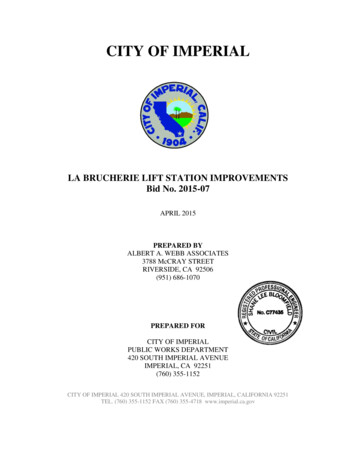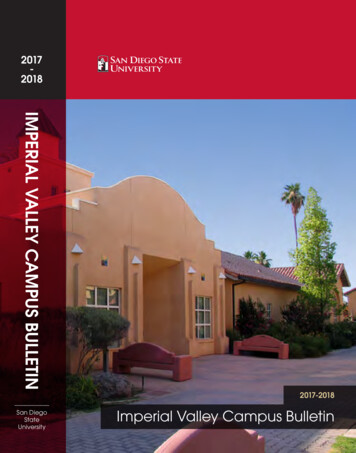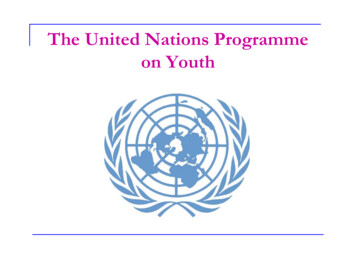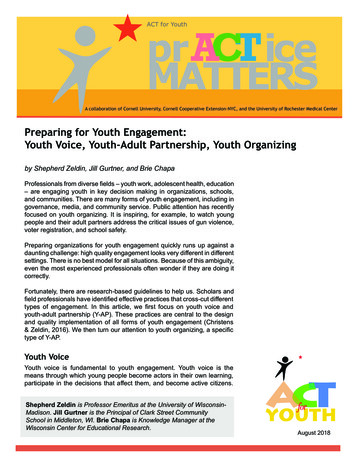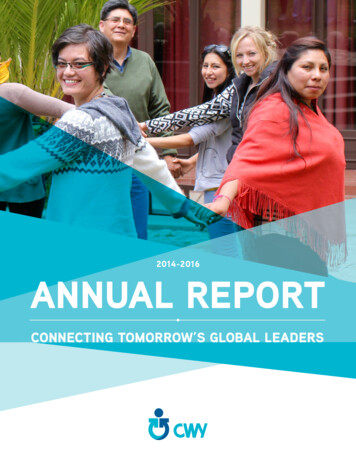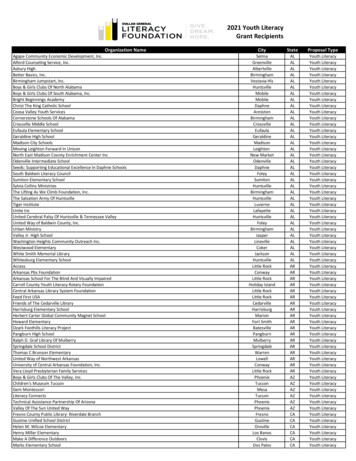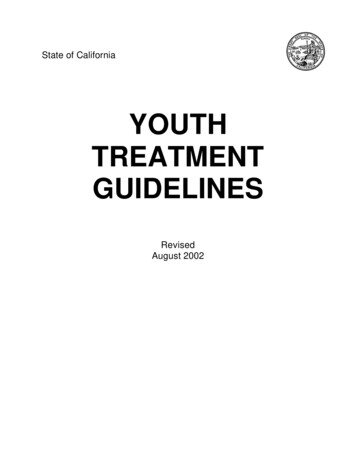
Transcription
State of CaliforniaYOUTHTREATMENTGUIDELINESRevisedAugust 2002
Youth Treatment GuidelinesTable of ContentsExecutive Summary ivIntroduction .vSection I.Definitions . . 1Section II.Guiding Principles for Youth Treatment .3Section III.Target Population . . .4Section IV. Outcomes .4Section V.A.B.C.D.E.F.G.H.I.J.K.L.M.N.Service Components . . .4OutreachScreeningInitial and Continuing AssessmentDiagnosisPlacementTreatment PlanningCounselingYouth Development Approaches to TreatmentFamily Interventions and Support SystemsEducational and Vocational ActivitiesStructured Recovery Related ActivitiesAlcohol and Drug TestingDischarge PlanningContinuing CareSection VI. Service Coordination and Collaboration .12A.Case Management and Complementary ServicesB.Critical Linkagesii
Table of Contents (continued)Section VII. Culture and Language . . .13Section VIII.A.B.C.D.E.Health and Safety Issues . . .14Care and SupervisionMedication ManagementEmergency ServicesDetoxification ServicesBuildings/GroundsSection IX.A.B.C.Legal and Ethical Issues .16Voluntary TreatmentConsent, Confidentiality, and Criminal ReportingNotice of Program Rules, Client Rights, and Grievance ProceduresSection X.A.B.C.Administration 17Program Rules and ProceduresProgram StaffingProgram Data Collection and Reporting(800) 879-2772 (California Only)(916) 327-3728FAX: (916) 323-1270TTY: (916) 445-1942Internet: http://www.dhcs.ca.govEmail: ResourceCenter@dhcs.ca.govCalifornia Department OfHealth Care ServicesSUD Resource CenterMS 2623P.O. Box 997413Sacramento, CA95899-7413iii
EXECUTIVE SUMMARYNumerous studies periodically document the substantial prevalence of alcohol and otherdrug (AOD) use among youth. Alcohol remains the most widely used substance amongyouth, and marijuana is the most frequently used illicit drug among older students.Inhalants are most popular among younger students and its use is at an all time high.Recent trends indicate that the onset of AOD use is occurring at younger ages, andthere are alarming increases in the use of “club drugs” such as methamphetamine,MDMA (ecstasy), gamma-hydroxybutyrate (GHB), Rohypnol and Ketamine.Far from being an isolated problem, early and persistent AOD use is part of a syndromeof problem behaviors that affect not only the youth themselves, but their families andcommunities as well. Academic difficulties, criminal activity, health-relatedconsequences, poor peer and family relationships, mental health issues, early sexualactivity and teen pregnancy often accompany AOD use. Adolescence is an importanttime of physical growth and psychosocial maturation, and AOD use interferes with thesenormal developmental phenomena. AOD use can cause delays or long-term deficits innormal physical, intellectual, social, and emotional development. When AOD usebegins at an early age, it can result in permanent developmental and neurologicaldamage.Most systems serving youth report that AOD use is a major problem among the youththey serve; however, those in need of treatment are not consistently identified orreferred for services. Generally, only those youth which cause serious problems inrelation to their AOD use tend to be identified and receive services, usually in the mostrestrictive settings (group homes, juvenile hall, or correctional institutions). This lack ofintervention and treatment results in a huge cost to society, which escalates over timeas these youth reach adulthood and enter the criminal justice system or require moreserious and costly services.For the most positive outcomes among youth experiencing AOD-related problems, theymust have access to age-appropriate intervention and treatment, practical support suchas life skills training and employment, and meaningful opportunities for involvement andleadership. Youth need programs that address their developmental issues, providecomprehensive and integrated services, involve families, and allow youth to remain inthe most appropriate, but least restrictive setting, so they can be served within thecontext of their families, classroom and community. Historically, the AOD treatmentservice system has not served youth well because it was designed and intended foradults.California has a pressing need for a coordinated system of treatment services designedspecifically for youth with AOD problems. The model system will provide multiple anddiverse services and treatment approaches to holistically address a youth’s AODrelated problems, surround youth with opportunities to succeed, and prevent moresevere problems in adulthood. These guidelines are an important part of a long-termeffort targeting the youth population with comprehensive and integrated services.iv
INTRODUCTIONIn 1998, the California Legislature enacted the Adolescent Alcohol and Drug Treatmentand Recovery Program Act (Assembly Bill 1784, Baca, Chapter 866, Statutes of 1998),better known as the Baca bill. Approximately 5 million annually was designated tosupport comprehensive alcohol and other drug (AOD) treatment for adolescents.Twenty counties were funded with Adolescent Treatment Program (ATP) funds basedon an index of need indicators (adolescent deaths, hospitalizations, arrests, automobilecollisions, and school incidents, related to adolescent AOD use.)The Baca bill authorized the Department of Alcohol and Drug Programs to developstandards and procedures to implement the ATP. The Department established astandards development workgroup. This workgroup was comprised of representativesfrom various disciplines and county systems, with a wide range of expertise in areassuch as youth AOD abuse and treatment; adolescent development; youth mental healthissues; child welfare, family reunification, and foster care; juvenile justice and probation;education; and, research and evaluation. The first meeting of the standards workgroupwas held in March 2000.Until recently, there were few AOD treatment programs designed specifically for youthand no standards of practice for youth or safeguards to ensure their safety andprotection. As counties and providers began to develop new youth programs, this lackof standardization and youth treatment resources presented implementation problems.Current AOD standards and regulations offered little assistance, as they have nospecifics related to youth and their unique needs. Therefore, the immediate goal of theworkgroup was to identify and document the treatment models and interventionresearch had found to be effective with youth. These best practices were included inthis document to ensure that youth intervention and treatment services are safe,appropriate, and cost effective. They were developed and intended to be used inconjunction with, not to conflict with or duplicate, other applicable laws, regulations orstandards that govern programs serving youth.These guidelines focus on ways to specialize treatment for youth and provide guidanceto counties and providers as they develop and operate their youth treatment services. Itis hoped that the guidelines will also serve as: 1) an educational resource forpolicymakers and professionals working in other youth services systems; 2) a guide forjuvenile and family court judges for choosing and placing youth in effective programs;and, 3) a benchmark for counties and programs to establish their own written protocolsfor youth AOD treatment services based on local need.v
SECTION I. Definitions“ADA” means the federal Americans with Disabilities Act.“Adolescence” means the period of life between puberty and maturity, which isgenerally accepted as the ages 12 through 17, inclusive.“Assessment” is an ongoing process by which the treatment team collaborates with theyouth, family, and others to gather and interpret information necessary to determinetheir level of problem severity, match their clinical needs to the appropriate level oftreatment, and evaluate progress in treatment.“AOD” means alcohol and other drugs.“ASAM” means the American Society of Addiction Medicine.“Case management” means an ongoing process by which the program establisheslinkages with other service systems and its providers, acts as liaison between the youthand those other systems, and coordinates referrals to ensure access to necessaryservices to assist youth and their families to address their special needs.“Clinically managed residential treatment” means the level of care equivalent toAdolescent Level III in the ASAM PPC-2R. This level of care is provided in either afacility licensed by the Department of Social Services or in a Department-licensed adultalcoholism or drug abuse recovery or treatment facility with an approved waiver to serveadolescents.“Co-existing disorders” means the co-existence of both a DSM IV-defined substancerelated disorder and an Axis II, III, IV, or V mental health disorder.“Co-morbidity” means the co-existence of both a DSM IV-defined substance relateddisorder and an Axis I major mental health disorder (also known as dual diagnosis).“Continuum of care” means a full range of AOD services available to address thediverse needs of youth. A full continuum of care generally includes prevention,intervention, and treatment, with a variety of settings and services included within eachcategory.“Department” means the Department of Alcohol and Drug Programs.“Detoxification” means acute abstinence syndrome requiring medical monitoring andmanagement.“Diagnosis” means a process of examination to determine the nature of a problem orset of problems, and the decision or opinion based on that examination.Page 1 of 18YOUTH TREATMENT GUIDELINES
“DSM IV” means the Diagnostic and Statistical Manual of Mental Disorders IV.“Early Intervention” (or secondary prevention) means the level of care equivalent toAdolescent Level .05 in the ASAM Patient Placement Criteria for the Treatment ofSubstance Related Disorders, Second Edition-Revised (PPC-2R). This level of care isdelivered in a variety of settings and usually consists of brief contact or a series ofcontacts designed to explore and address problems or risk factors that appear to berelated to substance abuse. It is most appropriate for youth with low AOD problemseverity (experimental and regular use) and those who do not meet the diagnosis for asubstance related disorder.“Family” means the nuclear family (parents, grandparents, siblings, stepparents,adoptive parents, foster parents, or legal guardians), extended family (aunts, uncles,cousins), significant others, mentors, or persons viewed as family members when ayouth has no identifiable family.“Group home” means a facility licensed by the Department of Social Services, whichprovides 24-hour nonmedical care and supervision to children in a structuredenvironment.“Intensive outpatient treatment” (or day treatment) means the level of care equivalentto Adolescent Level II in the ASAM PPC-2R. This level of care is usually provided in aschool or community-based program that extends the school day to include a wide arrayof services. It is appropriate for youth with severe problems related to their AOD usethat have the potential to distract from recovery efforts.“Medically-managed residential treatment” means the level of care equivalent toAdolescent Level IV in the ASAM PPC-2R, and is appropriately provided only in ahospital setting.“Outpatient treatment” means the level of care equivalent to Adolescent Level I in theASAM PPC-2R. This level of care may be provided in any age-appropriate setting andis appropriate for youth with low to medium problem severity.“Screening” means the use of a brief and simple questionnaire to identify youth thatmay need AOD treatment by uncovering indicators of AOD problems.“Substance abuse” means alcohol and other drug abuse.“Youth” means the period of life between childhood and maturity.“Youth development philosophy” means a concept that promotes developmentalasset building, social supports and services, and job skill and workforce opportunities tohelp reduce problem behaviors and produce positive long-term outcomes for youth.Page 2 of 18YOUTH TREATMENT GUIDELINES
“Youth in at-risk environments” are minors whose environment increases theirchance of using alcohol and other drugs, dropping out of school, teen pregnancy, andinvolvement in criminal activity.SECTION II. Guiding Principles for Youth TreatmentThese guidelines incorporate scientific research and clinical practice from both the AODtreatment field and children’s service systems. They reflect the overarching principlesof AOD treatment that characterize the most effective approaches and interventions,and the philosophy of care for children that recognizes their developmental and multipleneeds, involves families, and assures child safety.AOD abuse and dependence among youth is a complex problem. It is generally theresult of multiple factors, including: 1) a biological predisposition toward substance useor other problem behaviors; 2) psychological factors such as depression or distress;and, 3) social factors such as family, community, and peer relationships.Biopsychosocial factors should be considered in order to maximize the benefit youth willobtain from treatment. The biopsychosocial model integrated into these guidelines willhelp draw attention to the complexity of factors that lead to substance related disordersand aid in understanding and treating these disorders.Substance-related disorders among youth occur in varying degrees of severity. Ayouth’s AOD use can range from experimental use with minimal consequences toabuse and dependence with continued severe consequences. The level and type oftreatment provided should be consistent with the youth’s degree of AOD problemseverity. The adolescent criteria in ASAM’s Patient Placement Criteria for theTreatment of Substance Abuse Related Disorders is available to determine appropriateplacement.A full continuum of care should be available to address the varying levels of servicesneeded by youth, and allow for movement back and forth across levels as treatmentprogresses or regresses. In addition to formal treatment, the continuum of care foryouth and their families should include pre-treatment options (mentoring, briefinterventions, harm reduction, etc.), relapse prevention (either before, during, or afterformal treatment), and aftercare services.Page 3 of 18YOUTH TREATMENT GUIDELINES
SECTION III. Target PopulationA.The target population for youth treatment is individuals ages 12 through 17(inclusive).B.To serve youth ages 18 through 21 and individuals younger than age 12, theprogram should:C.1.Document clinical appropriateness individually for each client; and,2.Have a written protocol that addresses developmentally appropriateservices for that age group.Admission priority should be based on program design, client assessment, andclinical judgement.SECTION IV. OutcomesA.B.Counties should assess the desired system level outcomes, such as:1.increases in youth-specific programs/treatment capacity;2.increased access to youth specific services;3.increased quality of services; and,4.achieving and maintaining a continuum of care for youth.Programs should assess the desired client level outcomes for youth in treatment,such as:1.reduction and/or elimination of AOD use;2.improved level of functioning in major life domains; and,3.placement and safe treatment in the most appropriate, least restrictivesettings.SECTION V. Service ComponentsA.Outreach1.Counties should provide or arrange for outreach services that identifyAOD-abusing youth and encourage them to take advantage of treatmentservices.Page 4 of 18YOUTH TREATMENT GUIDELINES
B.2.Outreach efforts should target youth in at-risk environments.3.High priority should be placed on linking with public systems alreadyserving youth with AOD problems, such as schools, child welfare, publichealth, mental health, and juvenile justice.4.Outreach activities should also include educating professionals and policymakers in these systems so that they become referral sources forpotential clients.ScreeningYouth are far less likely than adults to be referred to treatment by a parent, familymember, or self. Therefore, it is important that professionals who work withyouth be able to identify youth AOD problems and refer these youth for furtherassessment and/or treatment. A high priority should be placed on identifyingchildren with AOD problems within other public service systems, such asschools, child protective services, county mental health, perinatal AOD programs,probation, and, Medi-Cal and Healthy Families programs.C.1.Youth who have been identified to be at risk for AOD problems should bescreened, using a tool designed for adolescents, to uncover indicators ofAOD and related problems. Youth with possible AOD problems asidentified through the screening should be referred for a morecomprehensive assessment for substance related disorders, as describedin “C” of this Section.2.The screening tool should be brief and simple and should be easilyadministered with minimal training.3.The screening tool should have applicability across diverse populationsand be developmentally appropriate.Initial and Continuing AssessmentAssessment is not a single event upon the youth’s admission to the program, butan ongoing process to gain insight into a youth’s unique abilities, strengths, andneeds. Assessment should be comprehensive, multi-faceted, and culturally, aswell as developmentally, appropriate. Assessment should be used in thetreatment planning of each individual admitted to treatment, and incorporatecontextual factors contributed by family/caregiver circumstances.1.Except for early intervention programs, the program should complete acomprehensive assessment on all youth with indications of possible AOD-Page 5 of 18YOUTH TREATMENT GUIDELINES
related problems (as a result of a brief screening), including those beingadmitted to treatment.2.After screening indicates a probable need for treatment, the assessmentshould provide the information necessary to determine and document thelevel of severity of the youth’s AOD-related problems and specificallyaddress the level of care he/she should receive, as described in “E” of thissection.3.The assessment tool should be designed specifically for the developingadolescent, have established reliability and validity, and capture datarelated to the major life domains of an adolescent. This assessment toolshould include, but not be limited to, issues of substance abuse, mentalhealth, physical health, legal, development, school/education/employment,and family/peer relationships. The assessment tool should also bestrength-based in order to accurately assess the youth’s unique abilitiesand needs. As recommended, a staff person qualified to administer theinstrument should perform assessments.4.The assessment should include a health screening (including a medicalhealth history, disease screening, dental, and mental health). (Programsassessing a youth should seek advice from public health professionalswhenever appropriate.) If the health screening identifies an issue thatwarrants further evaluation, the program should provide or arrange for aphysical examination and/or referral to the public health department orother appropriate care site, and take reasonable steps to assist the minorin accessing and receiving necessary care. Programs should develop andkeep current lists of adolescent health provider referrals and provideappropriate assistance in accessing necessary health care services basedon health assessment findings.5.The assessment should include an evaluation of the youth’sdevelopmental and cognitive levels; and social, emotional, communicationand self-help/independent living skills.6.As soon as possible, the program should assess and identify safetyissues, such as risk of suicide; current, or history of, physical and/orsexual abuse; or perpetration of physical or sexual abuse on others. Theassessment should include an evaluation of risk to self and others. If theassessment indicates high risk of danger to the youth or others, anappropriate referral should be made immediately and the family/guardianshould be notified. The assessment should be conducted with appropriateconsent as provided by law.Page 6 of 18YOUTH TREATMENT GUIDELINES
7.D.E.The initial assessment should be completed as soon as possible, with theinitial assessment occurring no later than 30 days after admission.Programs should attempt to gather as much information as soon aspossible, and keep updating as more information is obtained (it may takesome time to build trust and rapport with the youth before he/she willreveal more detailed and honest information).Diagnosis1.As part of the comprehensive assessment described in “C” of this Section,youth should be assessed to determine whether they meet the diagnosticcriteria of a substance related disorder in DSM IV.2.Except as provided in 3 and 4 below, all youth accepted for treatment inoutpatient, intensive outpatient, and residential treatment should meetdiagnostic criteria for a substance related disorder in the DSM IV.3.A youth whose AOD use symptoms are severe, but who does not meetthe diagnostic criteria, may be appropriate for admission to outpatienttreatment for further evaluation.4.If the presenting AOD history is not adequate to substantiate a diagnosis,the program may use material submitted by collateral parties (familymembers, legal guardians, etc.) that indicates a high degree of probabilityof such a diagnosis.PlacementIndividuals and agencies making placement decisions for youth needingtreatment should do the following:1.Make every effort to keep the youth in the least restrictive environment,unless moving them into a more restrictive program is the only way toprotect themselves or others from harm, or if all potential less restrictiveenvironments have proven ineffective. ASAM’s PPC provides a guidelinefor determining treatment setting and service matching.2.Take into consideration the age, developmental stage, gender, culture,and behavioral, emotional, sexual or criminal problems of the youth andexisting clientele, to ensure that the youth and other clients would not beadversely impacted by their interaction.3.Except for early intervention programs, a program should serve maleyouth only, or female youth only, unless:Page 7 of 18YOUTH TREATMENT GUIDELINES
a.b.F.G.the program addresses gender-specific issues in determiningindividual treatment needs and therapeutic approaches; and,the program provides regular opportunities for separate gendergroup activities and counseling sessions.Treatment Planning1.Except for early intervention programs, programs should develop a writtenindividual treatment plan for each youth, based on information collected inthe comprehensive assessment.2.The treatment plan sho uld be developed in conjunction with the youth andinvolve the youth in recognizing and appreciating his/her unique strengthsand assets as well as clarifying needs.3.The treatment plan should address multiple problems experienced by theyouth (including but not limited to mental health, education, family, medicalillness, legal issues), and the complementary services needed to deal withthese problems.4.Services and therapeutic approaches identified in the treatment planshould reflect the youth’s gender, and chronological, emotional, andpsychological age.5.A physical health questionnaire designed for client and/or parent/guardianself-administration should be used and discussed with the youth by anappropriately trained staff member in the context of treatment plandevelopment. Treatment plans should contain specific goals for achievingphysical health based on the identified needs and treatment plan priorities.6.The treatment plan should include goals with realistic objectives andtimeframes for completing. These should be mutually agreed upon by theprogram, the youth, and, whenever possible, his or her family/caregiver.7.The initial treatment plan should be completed at least within 30 days ofadmission. Progress in treatment should be regularly monitored andtreatment plans modified as needs arise or change during treatment, atvarious stages of the youth’s development and recovery, or at least everysix months.Counseling1.Except in early intervention programs, each youth should be assigned aprimary counselor when admitted to treatment. The primary counselor isresponsible for building the youth’s emotional trust and safety, recognizingPage 8 of 18YOUTH TREATMENT GUIDELINES
the youth’s individual strengths and assets, and assisting him/her toachieve success appropriate for his/her developmental stage.2.The program should provide individual counseling sessions as clinicallyappropriate and specified in the treatment plan, but at least:a.b.c.d.e.H.upon admission to treatment to help orient the youth to treatment;to develop and revise treatment plans;as needed for youth who are uncomfortable with the group processor unready to discuss specific issues in a group setting;for crisis intervention; and,for discharge planning.3.Programs should provide group counseling sessions as clinicallyappropriate and as identified in the treatment plan.4.The program should provide didactic groups as clinically appropriate andas identified in the treatment plan.Youth Development Approaches to Treatment1.Programs should integrate a youth development philosophy as thefoundation of treatment for youth. Youth development approaches includethe following:a.b.c.d.2.assessment and treatment planning processes that are strengthbased rather than deficit-based;uncovering what is unique about the youth and building on his/herindividual abilities and strengths;frequent expressions of support and consistent, clear andappropriate messages about what is expected of the youth; and,encouragement and assistance in developing multiple supportiverelationships with responsible, caring adults.Programs should provide or arrange for opportunities for youth to:a.b.c.d.e.advise and made decisions related to program policies andprocedures that impact them;plan, organize, and lead program activities and projects;develop social skills and decision-making abilities;learn values and marketable skills for adulthood; and,contribute to their community and serve others.Page 9 of 18YOUTH TREATMENT GUIDELINES
I.Family Interventions and Support SystemsResearch has found that effective treatment for youth almost always involves thefamily, and the effectiveness of family therapy has been documented extensively,especially among those youth who are normally the most difficult to treat.Therefore, whenever possible, parents/caregivers should participate in all phasesof their child’s treatment. However, it makes no ethical or legal sense to insist onthe involvement of estranged parents in decision-making regarding their child’streatment. Instead, the program should create new opportunities for youth todevelop supportive relationships with appropriate adults who will remain involvedin their lives, both during treatment and recovery, and beyond.1.Programs should make efforts to:a.b.2.J.identify family dynamics, engage and include the family in theyouth’s treatment as early as possible (as part of the intake andassessment process), if clinically appropriate and specified in thetreatment plan; and,provide individual family counseling, multi-family groups, andparental education sessions as clinically appropriate and specifiedin the treatment plan.The program should assist the youth in developing a support system tohelp reinforce behavioral gains made during treatment, and provideongoing support to prevent relapse.Educational and Vocational Activities1.Programs should fully integrate the youth’s educational program into theyouth’s clinical program by:a.b.c.2.providing youth access to educational instruction while in treatment,in accordance with state law;working with the educational system to address the youth’s schoolrelated problems; and,developing a plan to assist the youth to successfully transition backinto the community educational system, if appropriate.Programs should provide or arrange for educational sessions andculturally appropriate materials that address issues such as HIV/AIDS andother health matters (Sexually Transmitted Diseases (STDs), tuberculosis,hepatitis, nutrition), as well as, sexuality/family planning, violenceprevention, independent living skills, and smoking cessation.Page 10 of 18YOUTH TREATMENT GUIDELINES
3.K.As appropriate, programs should provide or arrange for academic andwork-readiness skills, career planning, and job training for youth. Theprogram should also develop and maintain collaborations with localvocational programs and the workforce investment board and its youthcouncil.Structured Recovery-Related ActivitiesIntensive outpatient and residential programs should provide or arrange for boththerapeutic and diversionary recreation. Therapeutic activities include arttherapy, journal writing, and self-help groups. Diversionary recreation activitiesinclude sports, games, and supervised outings.L.M.Alcohol and Drug Testing1.Except for early intervention programs, programs should provide orarrange for alcohol and drug testing for all youth.2.The frequency of alcohol and drug testing should be determinedindividually for each youth based on clinical appropriateness, and shouldallow for rapid response to the possibility of relapse.3.Alcohol and drug test results are meant to assist in diagnosis, confirmclinical impressions, help modify the youth’s treatment plan, anddetermine the extent of the youth’s reduction in AOD use. Clinicaldecisions should not be based solely on these results.Discharge Planning1.Except for early intervention programs,
SUD Resource Center MS 2623 P.O. Box 997413 Sacramento, CA 95899-7413. iii (800) 879-2772 (California Only) (916) 327-3728. FAX: (916) 323-1270. TTY: (916) 44. . of standardization and youth treatment resources presented implementation problems. Current AOD standards and regulations offered little assistance, as they have no .
